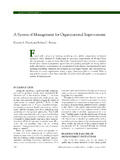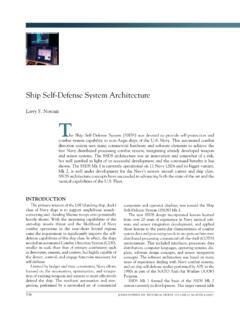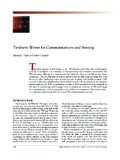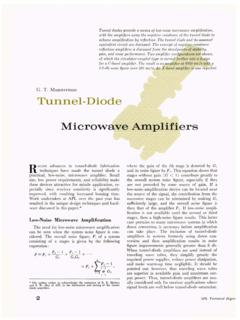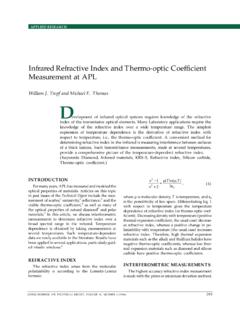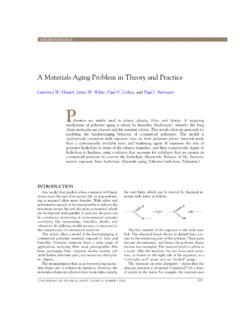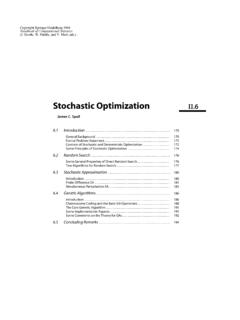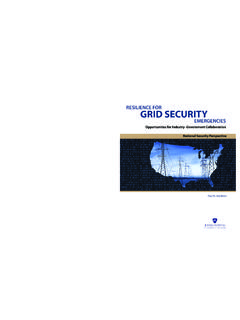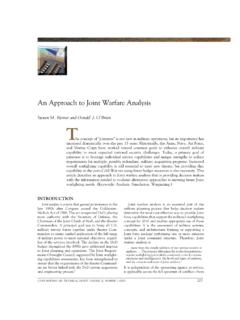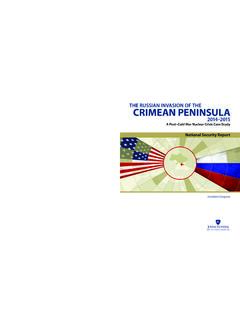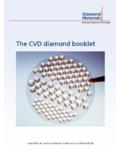Transcription of OPTICAL PROPERTIES OF DIAMOND - The Johns …
1 MICHAEL E. THOMAS and WILLIAM J. TROPF. OPTICAL PROPERTIES OF DIAMOND . DIAMOND offers unique PROPERTIES for OPTICAL elements and coatings. This article reviews the PROPERTIES of DIAMOND and presents the results of recent measurements and efforts in the modeling of its OPTICAL PROPERTIES at the Applied Physics Laboratory. INTRODUCTION TYPES OF DIAMONDS. In the past, the commercial use of diamonds was re- Four classifications of natural DIAMOND have been made stricted to poor OPTICAL quality "industrial diamonds" for on the basis of OPTICAL PROPERTIES . Only Type IIa is suitable cutting and grinding. These diamonds were either natural for infrared optics. diamonds unsuitable for gems or were manufactured by Type fa accounts for 95 to 98% of natural DIAMOND and subjecting graphite, the stable form of carbon at ambient contains substantial nitrogen impurity (up to ), which conditions, to intense pressure and temperature. The use forms in aggregates or platelets. This type of DIAMOND has of DIAMOND as an OPTICAL material was restricted to a few strong absorption below 320 nm, low thermal conductivity specialized applications such as planetary radiometry 9 W/[m K]), and high electrical resistivity (> 10 14 n m).
2 From satellites ( , Nimbus and the Pioneer series) and Type fb also has substantial nitrogen but in a dispersed high-pressure cells (" DIAMOND anvils"). Recent progress substitutional form. The nitrogen imparts color, ranging in the manufacture of high-quality diamonds through the from pale yellow to green, depending on nitrogen concen- chemical vapor deposition (CVD) process opens the pos- tration. Synthetic industrial diamonds are typically Type lb. sibility of their use in new commercial applications, Type IIa is gem-quality DIAMOND essentially free of ni- including semiconducting DIAMOND electronic devices, trogen. This type has the highest thermal conductivity DIAMOND substrates as heat sinks, and durable OPTICAL (>2000 W/[m-K]), high electrical resistivity (>10 14 n m), elements with wide transmission ranges. and good OPTICAL transmission. DIAMOND is thermodynamically unstable at pressures Type lIb is also nitrogen-free but contains boron impurity below gigapascals (GPa), but conversion to graphite (up to ppm in natural DIAMOND and up to 270 ppm in is extremely slow at temperatures below 1500 K.)
3 Dia- doped synthetic DIAMOND ) that results in p-type conductivity mond synthesis was first performed by the General Elec- (electrical resistivity to 100 n m) and imparts a blue tric Company in 1955 using pressures of to 6 GPa color to the DIAMOND . and temperatures of 1600 to 1900 K, which are thermo- dynamically stable conditions for DIAMOND . Molten metal catalysts cause DIAMOND to form at practical rates (Fig. 1). These films have great promise for OPTICAL (in- at these relatively low (for carbon) temperatures. Non- frared) elements and hard OPTICAL coatings. catalytic DIAMOND synthesis requires higher temperatures Our interest in CVD DIAMOND is principally as a long- (2::2500 K) and pressures (~10 GPa). These conditions wavelength OPTICAL window for infrared sensors. Dia- typically yield micrometer-sized DIAMOND powder, but mond offers extreme hardness and strength, excellent gem-quality single crystals can be grown. 1 transparency, resistance to chemical attack, performance Development of new CVD DIAMOND growth techniques at higher temperatures, and better thermal shock capabil- began in the early 1980s by the Japanese and, by the end ity compared with other long-wavelength window mate- of the decade, it became possible to make large structures rials such as zinc sulfide, zinc selenide, and gallium ar- of high-quality polycrystalline DIAMOND 2 - 3 whose me- senide.
4 Chanical,4 thermal,s -7 and OPTICAL PROPERTIES approach those of Type IIa natural diamonds (see the boxed insert). PROPERTIES OF DIAMOND . A major advantage of the CVD technique is that growth The unique PROPERTIES of pure (Type IIa) diamondS. can occur at lower temperature (~1200 K) and very low arise primarily from its structure. DIAMOND has a face- pressure (2500 Pa). Films are grown on a temperature- centered, cubic, close-packed structure with the greatest controlled, heated substrate, such as silicon, metal ox- atomic number density of any material ( X 1023 at- ides, or refractory metals, using methane or acetylene oms/cm 3). The individual carbon--carbon bonds are not (mixed with hydrogen and other gases) as a source of especially strong, but the tetragonal symmetry and high carbon (CH 3 is the active radical). Microwaves, hot coordination number of cubic Group IV elements (car- sparks, hot filaments, or other techniques are used to bon, silicon, and germanium) impart unusual stiffness, dissociate the gases partially.
5 The various CVD techniques strength, and hardness through the number and symmetry produce high-quality polycrystalline DIAMOND films of the bonds and close packing of light atoms. Table 1. 16 fohns Hopkins APL Technical Digest, Vo lume 14, Number 1 (1993). Figure 1. Polycrystalline DIAMOND win- dows made by Norton (DiamaTorr pro- cess). The square windows are 1 in. on a side and are polished ; the 4-in. circu- larwafer is unpolished. All samples are about thick. The slight brown coloring is due to scatter. (Photograph courtesy of the Norton DIAMOND Film Company.). compares the hardness of DIAMOND with other very hard Table 1. Comparison of the Knoop hardness of DIAMOND with that materials. DIAMOND is the stiffest, strongest, and hardest of other hard materials. 8. known material by at least a factor of 2. 8. In addition to DIAMOND 's unique mechanical proper- Hardness ties, its thermal PROPERTIES are also unusual. The strong Material (kg/rrun 2). net bonding results in very low thermal expansion, high DIAMOND 9000.
6 Acoustic frequencies (and hence a very high Debye tem- Boron nitride 4500. perature of 2220 K), and low room-temperature heat Boron carbide 2250. capacity. Even more remarkable is the exceptionally high Tungsten carbide 2190. room-temperature thermal conductivity of DIAMOND , Sapphire 2000. which is more than five times that of metals such as silver or copper. This large thermal conductivity results in high resistance to thermal shock and thermal lensing. Table 2 compares the thermal conductivity of natural Table 2. Thermal conductivity of DIAMOND . diamonds and CYD diamonds. Thermal conductivity is a strong function of impurities (especially nitrogen), defect concentration, and isotopic content. Recent research on Thermal conductivity the thermal conductivity of DIAMOND shows a 50% in- Type (W/[m KJ). crease when Be content is reduced to % (from its Natural, IIa lO,11 2000 to 2300. natural % abundance). 1,9 The thermal conductivity of (or artificial). recently developed thick polycrystalline DIAMOND films Natural,Ia 1,8,1O,1l 800.]
7 Approaches that of a single crystal. ( X lO2D/ cm3 N). Type IIa DIAMOND is an excellent insulator and is re- Artificial,I ,9 3320. sistant to chemical attack at ordinary temperatures. Di- ( 12C). amonds heated above 875 K in the presence of oxygen CVD5-7 1280 to 1700. or other catalytic agents form a graphite surface coating. Oxidation rates are ILm/h at 600 C and 4 ILm/h at 700 C. 12 In vacuum, significant conversion to graphite ("graphitization") requires temperatures above 1800 K. OPTICAL activity (no interaction of light with lattice vibra- Table 3 summarizes the PROPERTIES of Type IIa dia- tions) . To first order, DIAMOND is transparent from its mond. Additional electronic, lattice, and transport prop- (indirect) electronic band gap (at 225 ILm) to the micro- erties are presented in standard wave region. Higher-order (multiphonon) lattice absorp- tion processes cause significant absorption in the to OPTICAL PROPERTIES OF DIAMOND 6-lLm region. DIAMOND has a Raman-active OPTICAL DIAMOND 's structure contributes to its unique OPTICAL mode22 (F2g or r (2S+) symmetry) at cm- 1 ( PROPERTIES , and its symmetry results in a pure covalent ILm).
8 A sharp Raman line indicates high-quality DIAMOND bonding, which accounts for the absence of infrared and is used as a qualitative measure of CYD films, al- Johns Hopkins APL Technical Digest, Vo lume 14, Number J (/993) 17. M. E. Thomas and W. 1. Trap! Table 3. Room temperature PROPERTIES of Type lIa DIAMOND . and infrared ( , at /Lm) absorption, slight birefrin- gence, and decreased thermal conductivity. 13 Metals such as iron, aluminum, magnesium, and others are believed Property Value to cause green and brown coloration. Type IIa diamonds Space group Fd3m (O~) are clear with very low concentrations of nitrogen Lattice constant l3 nm (Z = 8) (::;20 ppm), boron, and other impurities. Density 14 g/cm3 OPTICAL scatter in single-crystal Type IIa diamonds is Elastic moduli IS,a C II = GPa very low. Polycrystalline CVD DIAMOND has higher scatter c 12 = GPa caused by grain boundaries. Grain size and surface polish c44 = GPa determine the scatter level in CVD DIAMOND , and scatter Engineering moduli elastic: 1143 GPa can significantly limit transmission in the visible, ultra- (random average) shear: 535 GPa violet, and near-infrared regions.
9 28 Scatter in CVD dia- bulk: 442 GPa mond is recognized by a gray or brown cast to the sample Poisson's ratio and by uniformly decreasing transmission at high fre- Knoop hardness 8 9000 kg/mm 2 (500 g) quency. Strength 8 2500 to 3000 MPa Melting point l6 4100 K (P = GPa) Ultraviolet PROPERTIES Debye temperature8 2200K. Figure 2 shows an APL measurement of the ultraviolet Heat capacity 17 J/(mol K). transmission of a Type IIa DIAMOND window ( Thermal expansion l 8 X 1O- 6/K. thickness) in the region near its band gap. The extinction Thermal conductivitylO,ll 2300 W/(m K). coefficient also shown in Figure 2 is derived using the Band gap,19 index of refraction from Equation 1 and solving the Refractive index,20 n D resulting quadratic equation that relates the absorption Abbe number,b v D coefficient to transmittance. The exponential increase in . Dielectric constant,2 E absorption with frequency (or energy) near the band gap (dE/dT)p = X 1O- s/K. ( eV) is known as the Urbach edge. The ultraviolet (dE/dP)T = - X 1O- 12/pa absorption coefficient (3 can be modeled as a function of Note: Z = number of atoms in a unit cell.)
10 Energy E (in e V) and temperature T by the equation apressure and temperature dependence of the elastic constants can be found in H. J. McSkimin and P. Andreatch, "Elastic Moduli of DIAMOND as a Function of Pressure and Temperature," 1. Appl. Phys. 43, 2944-2948 (1972). (3(E, T) = (30 exp[a(T)(E - Eo)], (2). kBT. bReference 8, p. 650, gives refractive indices nc = , nD =. , nF = , and liD = ; source is unknown. where kB is Boltzmann's constant. Using the room-temperature absorption data of Figure though small grain size 'ARaman/2) reduces Raman inten- 2 and assuming a value of eV (the direct band gap). Nondiamond character is usually revealed by for the constant Eo of Equation 2, gives the following Raman response 2 near 1550 cm- I . parameters for the Urbach edge model: (30= X 1011. cm- \ a(300 K) = Temperature-dependent absorp- Visible PROPERTIES tion measurements are needed to derive the temperature The refractive index n of DIAMOND 24 - 26 is given by the dependence of aCT) and give the precise location of Eo.)
